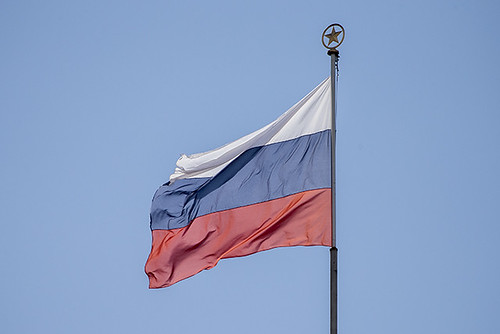Anthems of the Motherland
The history of the Russian national anthem takes many fascinating turns.

“Russian flag” by BWJones is licensed under CC BY-NC-ND 2.0.
With an anthem as well-known as the Russian anthem, it can be easy to forget that said anthem hasn’t always remained the same.
January 19, 2023
Each national anthem across the world is unique in its own right, but a personal favorite, as previously ranked, is the anthem of Russia. However, the glorious, patriotic tune that the world hears today has not always been the nation’s official anthem.
The earliest known official anthem was one used by Imperial Russia between 1816-1833, known as “The Prayer of the Russians” (or “Молитва русских” in Russian). However, upon first listening to the song, it may immediately sound familiar. This first anthem uses the same melody as “God Save The King,” the historical (and current) anthem for the United Kingdom.
“God Save The King” was first performed publicly in London in 1745, and had been gaining popularity even before becoming the official anthem of the United Kingdom. Many other European nations adopted the anthem in the nineteenth century, some of them–like Liechtenstein–still using the same melody today.

The lyrics for “The Prayer of the Russians” are very similar to those present in “God Save The King,” the premise simply being a tribute to the (supposed) glory and courage of the march (or Tsar or Tsarina in Russian).
This fixation on the monarchy would continue with the next anthem. From 1833-1917, the Russian Empire adopted a new anthem known as “God Save the Tsar!” (or “Бо́же, Царя́ храни́!” in Russian).
While the music itself sounds very different, the premise still remains the same–the glorification of the Tsar. “God Save The Tsar” is very short–being only two stanzas long–and takes much inspiration from “The Prayer of the Russians.”
However, respect for the monarchy would go on a rapid decline, and on March 8th, 1917–in the midst of World War I–the February Revolution came, ridding the country of the monarchy. In its place, a new provisional government was set up.
While never adopting an official anthem, the provisional government did establish an unofficial anthem in its short time in power, the “Worker’s Marseillaise” (or “Рабочая Марсельеза” in Russian).
However, similar to “The Prayer of the Russians,” the origins of “Worker’s Marseillaise” will immediately become clear; the anthem sounds identical to the French national anthem, “La Marseillaise.”
The only real distinction between the two anthems is the lyrics. “La Marseillaise” was created in the midst of the French Revolution. In response to the war against Austria–who wanted to undo the events of the revolution by restoring the monarchy–the song was created as a call to arms for French citizens.
The lyrics of its Russian counterpart are focused much more on the class divisions between the Russian nobility and monarch, and the peasants and workers. The “Worker’s Marseillaise” serves more as a call to action for the workers against an internal rich class, rather than a foreign enemy.
However, the Russian Republic would not remain stable for long, as failed offensives against the Germans only made the provisional government even more unpopular. In November of 1917, the October Revolution would bring the end of the provisional government and give rise to Soviet Russia.
After the Bolsheviks took over the nation, one of the first changes they made–surprisingly enough–was the national anthem. However, similar to their predecessors, they decided to…borrow some inspiration from the French.

“L’Internationale”, originally a French song created to unite the workers of the world under a (usually) socialist movement for rights, was adopted as the official anthem for Soviet Russia (and later the Union of Soviet Socialist Republics when it was established in 1922) from 1918 to 1944. Officially, the name of the song went under no changes, simply being known as “The Internationale” (or “Интернационал” in Russian).
The lyrics, while slightly altered, still hold the same meaning as their French counterparts–overthrowing tyranny, berating the evils of capitalism and class division, and calling for awareness and change for the working class.
But even though it would eventually be replaced, “L’Internationale” still remains prevalent in some nations of the world today, one of those being China. For example, on July 1st, 2021, the students and teachers of Tsinghua University–arguably the most prestigious university in China–created an amazing rendition of the song in a plethora of different languages. Additionally, “L’Internationale” was even played at the state funeral for former Chinese President, Jiang Zemin on December 6th, 2022.
But alas, for such a dominant nation of the 20th century, change was bound to occur. By 1942, millions of Soviet troops were bogged down in a brutal war against the Nazis. Morale was still running low, and they needed a boost. Thus Soviet dictator Joseph Stalin decided to revisit an old proposal from 1936–a new anthem.
A commonly missed point in the history of Russian anthems is just how the actual tune for the Soviet Union’s anthem came to be. Originally, the melody was composed by Alexander Vasilievich Alexandrov for a song exclusive to the Bolshevik Party known simply as, “Anthem of the Bolshevik Party” (or “Гимн партии большевиков”).
This melody was the very same one used for what would eventually become the “Anthem of the Soviet Union” (or “Гимн Советского Союза” in Russian).
The lyrics of this original Soviet anthem gave a sense of national unity through its lyrics. Being created during a time of war, many of the lines in the later half of the song were created to boost not only the morale of the Soviet people and soldiers, but also the glory of the state from its battles (and eventual victory) in WWII.
However, after the death of Stalin in 1953, a dramatic political shift occurred in the USSR. Stalin’s successor, Nikita Khruschev, in response to all of the former dictator’s brutal terrors, would begin a campaign of “de-Stalinization.” Since the original Soviet anthem included a line praising Stalin, the lyrics would be stripped away until 1977.
Obviously, having a simple tune with no lyrics for a national anthem as a global superpower wasn’t a good look. So in 1977, in light of the 60 year anniversary of the October Revolution, new lyrics were adopted.
The biggest change was obviously the removal of the line praising Stalin, instead passing on that praise to the state’s original founder, Vladimir Lenin. Additionally, the sense of nationalism and glory from military victory was cut back a bit in exchange for something different–the triumph of Communism. This can be seen with the changes made to the back half of the chorus, and the third stanza as a whole. These lyrics would be utilized until the fall of the USSR in 1991.
When the USSR was dissolved, Russia was left as an independent state. Wanting to let go of its Soviet past, President Boris Yeltsin decided on “Patrioticheskaya Pesnya” (or “Патриотическая Песня” in Russian), an old composition for the piano composed by Mikhail Glinka, as the official anthem for the Russian Federation. Lyrics were written, but never officially adopted, ultimately leading to another push for change.
Finally, in 2000, President Vladimir Putin would bring back the original Soviet tune, while also including a completely new set of lyrics, centered more towards Russian patriotism. The “State Anthem of the Russian Federation” (or “ Госуда́рственный гимн Росси́йской Федера́ции” in Russian), is still the official national anthem used in Russia today.
Looking at this full history of the Russian national anthem, it’s easy to see why so many are left forgotten. While they are all nice to listen to, many of the previous anthems were either borrowed from alternative sources, or extremely one-note. On the other hand, Alexandrov’s iconic tune–regardless of the lyrics that come with it–is simply a glorious, original, and memorable tune that cannot be beaten.
There are a lot–truly a lot–of glaring mistakes and horrifying decisions made by the Soviet Union. But one of the few, undisputedly positive contributions they made for Russia remains quite possibly the greatest national anthem of all time. Perhaps now, it may become apparent why so many recognize Alexandrov’s melody as the Soviet anthem, rather than the Russian anthem (and also why someone may rank the Soviet anthem over the Russian counterpart).












